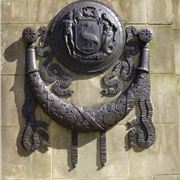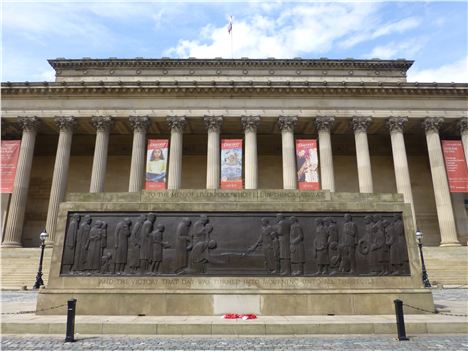LIVERPOOL'S cenotaph on St George's Plateau is to be awarded Grade I status, making it one of the three most important war memorials in the UK.
Culture Secretary Maria Miller, who leads on the government programme to mark the centenary of the First World War next year, made the announcement of the upgrade from Grade II status which was awarded in 1952.
Only two other war memorials hold the Grade I listing – London's Cenotaph at Whitehall and the war memorial in Victoria Park, Leicester, both by Sir Edwin Lutyens.
English Heritage will list up to 500 war memorials a year over the next five years, however, so widespread was the nation’s grief that it isn’t known how many war memorials there actually are. Now it is calling on the public to nominate their local memorials to be considered for listing.
Designed by Lionel Baily Budden and with bronze carvings by Herbert Tyson Smith, The Liverpool Cenotaph was reassessed by English Heritage based on its architectural and historic significance.
Pevsner describes it as “one of the most remarkable war memorials in the country, unflinching in its depiction of the scale of loss and grief and in its refusal of allegory or heroic idealisation.”
Roger Bowdler, Designation Director at English Heritage, agrees: “The Liverpool Cenotaph is a remarkable monument, combining the highest quality of design and artistry with a dignified and painfully poignant memorial to the losses suffered by the people of Liverpool. It fully deserves this designation at the highest grade.”
There are 1,300 free standing war memorials currently on the National Heritage List for England, however, it is believed that this is less than 10 percent of the total.
Bowlder added: Researching, recording and recommending up to 2,500 more war memorials for listing over the next five years is a major task but one that English Heritage is proud to undertake. These memorials will gain a place on the National Heritage List for England to tell the story of this country’s sacrifice and struggle.”
Solemn faces downcast, an elderly man stifles a sob
The Liverpool Cenotaph, which stands was designed by Liverpool University Architecture Professor Lionel Budden. The moving sculptural work was undertaken by Liverpool artist Herbert Tyson Smith and unveiled in 1930 and dedicated to the dead of the Great War.
In the form of a vast altar, it is decorated with bronze reliefs which are among the finest responses to remembrance ever created. One depicts massed ranks marching off to war. The other, unflinching in its depiction of the scale of loss and grief, shows row upon row of gravestones melting away into the distance and towards eternity; mourners in contemporary dress pay their respects, their solemn faces downcast and an elderly man stifles a sob.
 The inscription on the east face, which represents Liverpool on Armistice Day reads "To the men of Liverpool who fell in the Great War, and the victory that day was turned into mourning unto all the people".
The inscription on the east face, which represents Liverpool on Armistice Day reads "To the men of Liverpool who fell in the Great War, and the victory that day was turned into mourning unto all the people".
Survivors, all consumed with grief, file towards a central coffin and we see in the background to these figures, row upon row of gravestones; a depiction of a Great War Cemetery.
On the west face the relief depicts "The March to Action of the Fighting Services" and we see a representation of the relentless march to war of grim faced servicemen so many of whom were lost in the First World War.
The words read "As unknown and yet well know; As dying, and behold we live/Out of the North Parts....A Great Company and a Mighty Army".
Morris Singer & Co did all the bronze casting involved.
















